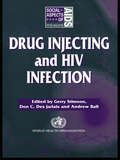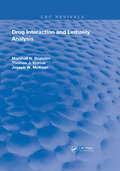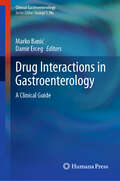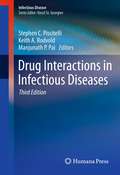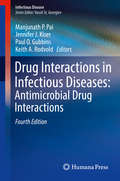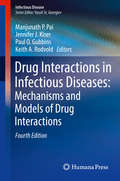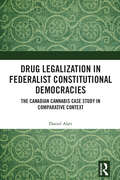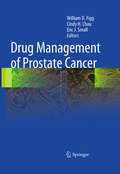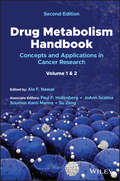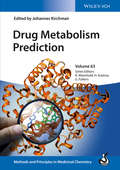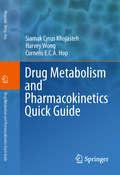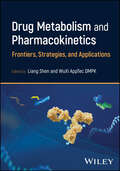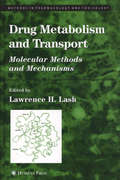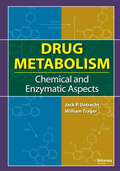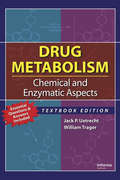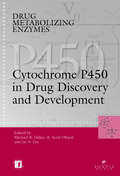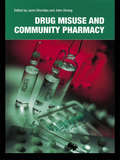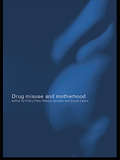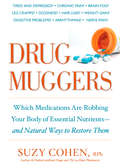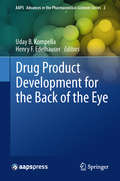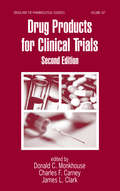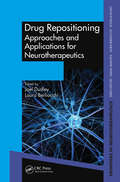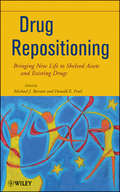- Table View
- List View
Drug Injecting and HIV Infection (Social Aspects of AIDS)
by Gerry V. Stimson Don C.Des Jarlais Andrew L. BallDrug Injecting and HIV Infection is a comparative international study of drug injecting behaviour and HIV infection based on the World Health Organization's study of 13 cities as disparate as Athens, Bangkok, Glasgow and Rio de Janeiro. Using a standardized methodology for the collection of data, as well as central data management and analysis, this study represents the largest international project of its kind. It presents a comprehensive overview of what is currently known about drug injecting, HIV infection, epidemic dynamics and possibilities for prevention. Stressing the importance of linking research to intervention and policy, the contributors emphasize the need to place HIV and policy issues on the international agenda. Written by experts in the field, this global study offers an in-depth and definitive analysis of the subject.
Drug Interaction & Lethality Analysis (Routledge Revivals)
by Joseph W. McKean Marshall N. Brunden Thomas J. VidmarFirst Published in 1988, Drug Interaction and Lethality Analysis offers a well-structured insight into the relationship between the chemicals we use in everyday life and the environment. With an abundance of references and detailed statistics, this book is highly recommended for students of Pharmacology and professionals in their respective fields.
Drug Interactions in Gastroenterology: A Clinical Guide (Clinical Gastroenterology)
by Marko Banić Damir ErcegThe risk of clinically significant drug interaction rises when a patient increases his intake of medication. While drug interaction can be a prominent cause of illness, in many cases, it can be avoided with proper knowledge and care. This text provides a concise yet comprehensive review of common drug interactions in gastroenterology. The book begins with a preliminary overview of GI drugs, focusing on legal aspects of drug use, clinical research and regulatory review, and drug development. The next section goes over the basic pharmacology of GI drugs, specifically profiling antisecretory drugs, motility drugs, mucosal protective agents, antibiotics, and anti-inflammatory drugs. The third section of the text reviews important aspects of drug interaction; topics covered in this section include the different types of drug interactions, adverse drug reactions and interactions, enzymes and transporters involved in drug interactions, pharmacogenomics, drug-herbal interactions, drug-food interactions, and ways to avoid drug interactions altogether. The book moves on to examine comorbidity and digestive diseases that can result from drug interactions, with particular emphasis on infections, cardiorespiratory disorders, renal insufficiency, IBS, metabolic disorders, and CNS disorders. This section also discusses the influence of age on drug interactions. The final section spotlights comedication that can be used to mitigate disorders caused by drug interactions, specifically reviewing comedication used to treat acid-related disorders, intestinal inflammation, liver disorders, pancreato-biliary disorders, and motility disorders. The text also includes over 100 high-yield illustrations, photographs, and tables.
Drug Interactions in Infectious Diseases
by Keith A. Rodvold Manjunath P. Pai Stephen C. PiscitelliThe revised and up-to-date third edition of Drug Interactions in Infectious Diseases delivers a text that will enhance your clinical knowledge of the complex mechanisms, risks, and consequences of drug interactions associated with antimicrobials, infection, and inflammation. The third edition features five new chapters that cover material not addressed in previous editions. These new chapters describe interactions with a number of drug classes such as non-HIV antiviral, antimalarial, antiparasitic, antihelmintic, macrolide, azalide and ketolide agents. A novel chapter on probe cocktail studies has been included to highlight an important research tool for drug development. These chapters address material that cannot be retrieved easily in the medical literature. The highly acclaimed food-drug interactions as well as the study design and analysis chapters remain definitive references. The newly written drug-cytokine interaction highlights the need for our improved understanding of the complex interrelationship of acute infection, inflammation, and the risk of drug interactions. Informative tables on specific drug-drug interactions are provided throughout the chapters as a quick clinical resource. The Third Edition of Drug Interactions in Infectious Diseases is a distillation of relevant drug interactions associated with antimicrobials, infection, and inflammation. This concise review of the mechanisms and strategies to manage drug interactions should be valuable to all health care practitioners. Features * Definitive reference source of up-to-date information on antimicrobial drug interactions * Informative tables on the degree of interaction for specific antimicrobial agents * In-depth discussion of mechanisms and potential mechanistic pathways of interaction * New chapters on non-HIV antiviral, antimalarial, antiparasitic, and macrolide, azalide and ketolide agents * New chapter on probe-cocktail studies as a research tool to study drug-drug interactions * Inclusion of new antimicrobial agents and their associated drug interactions * First rate chapters on study design and analysis, and drug-food interactions * A fresh perspective on drug-cytokine interactions * Authoritative chapter on regulatory considerations of drug interactions during drug development
Drug Interactions in Infectious Diseases: Antimicrobial Drug Interactions (Infectious Disease Ser.)
by Keith A. Rodvold Manjunath P. Pai Jennifer J. Kiser Paul O. GubbinsThe 4th edition of Drug Interactions in Infectious Diseases is being split into two separate volumes – “Mechanisms and Models of Drug Interactions” and “Antimicrobial Drug Interactions”. This volume, “Antimicrobial Drug Interactions,” delivers a quick clinical resource that distills relevant drug interactions by antimicrobial drug class. The book provides informative tables on specific drug-drug interactions that include the degree and severity of the expected interaction. A mechanistic basis for drug-drug interactions is also provided to link observed interactions to pharmacologic characteristics of key drug classes. This complete resource is organized by major antibacterial, antimycobacterial, antiviral, antifungal, antimalarial, and antiprotozoal class. In line with current innovations in antimicrobial drug development, a distinct chapter on the pharmacologic management of drug interactions in hepatitis B virus (HBV) and hepatitis C virus (HCV)-related infections is included. Two new chapters are dedicated to the management of human immunodeficiency virus (HIV) drug-drug interactions given the breadth of antiretroviral class-specific effects. This comprehensive review of known drug interactions and strategies to manage them is an invaluable resource to all health care practitioners.
Drug Interactions in Infectious Diseases: Mechanisms and Models of Drug Interactions (Infectious Disease Ser.)
by Keith A. Rodvold Manjunath P. Pai Jennifer J. Kiser Paul O. GubbinsThe 4th edition of Drug Interactions in Infectious Diseases is being split into two separate volumes – “Mechanisms and Models of Drug Interactions” and “Antimicrobial Drug Interactions”. This volume, “Mechanisms and Models of Drug Interactions,” delivers a text that enhances clinical knowledge of the complex mechanisms, risks, and consequences of drug interactions associated with antimicrobials, infection, and inflammation. The book provides a comprehensive review of basic clinical pharmacology with a focus on metabolism and transporter-mediated drug interactions. The chapters address materials that cannot be retrieved easily in the medical literature, including materials focused on the complex interrelationship of acute infection, inflammation, and the risk of drug interactions in the Drug-Cytokine chapter. The Food-Drug and Herb-Drug interactions chapters remain definitive resources. A new chapter on in vitro modeling of drug interactions is included along with updates on design and data analysis of clinical drug interaction studies. Authoritative discussion of models for regulatory decision-making on drug-drug interactions provides the necessary framework to aid antimicrobial drug development. This concise review of the mechanisms and models of drug interactions provides important insights to health care practitioners as well as scientists in drug development.
Drug Legalization in Federalist Constitutional Democracies: The Canadian Cannabis Case Study in Comparative Context
by Daniel AlatiThis book uses the Canadian Cannabis legalization experiment, analyzed in the historical context of wider drug criminalization in Canada, and placed in international perspective, to examine important lessons about the differential implementation of federal law in jurisdictions within federalist constitutional democracies. Utilizing a socio-legal, interdisciplinary methodology, the work provides a comprehensive history of federal drug policy and engages in a critical appraisal of its provincial implementation. It also presents a significant international and comparative component, bringing in analyses of the status of drug legalization in other federalist constitutional democracies. Readers of the book will thus gain a comprehensive knowledge of drug legalization in federalist constitutional democracies. They will also better understand the political and cultural factors that impact upon differential implementation of federal law in individual jurisdictions including, but not limited to, legacies of racism and stigmatization of drug use. Using the experience of Canada and other countries, future challenges and lessons to be learned for states considering federal drug legalization are analysed and explained. The book will be a valuable resource for students, academics and policy-makers in the areas of Criminal Law, Constitutional Law, Criminology, Socio-Legal Studies, Indigenous Studies, and Drug and Health Policy Studies.
Drug Management of Prostate Cancer
by Cindy H. Chau Eric J. Small William D. FiggThis book is a comprehensive, concise summary of the pharmacological treatments of prostate cancer. It is an authoritative and up-to-date reference on therapeutic options involving both standard of care and investigational agents. The chapters describe state of the art information on Hormone Therapy, Chemotherapy, Angiogenesis, Therapy for Bone Metastases, Immunotherapy, Prevention, and Drug Development. Drug Management of Prostate Cancer is an excellent resource for medical oncologists, trainees, researchers, and members of the pharmaceutical industry.
Drug Metabolism Handbook: Concepts and Applications in Cancer Research
by Paul F. Hollenberg JoAnn Scatina Soumen Kanti Manna Su ZengA comprehensive explanation of drug metabolism concepts and applications in drug development and cancer treatment In the newly revised second edition of Drug Metabolism Handbook: Concepts and Applications in Cancer Research, a distinguished team of researchers delivers an incisive and robust exploration of the drug metabolism system and a well-illustrated and detailed explanation of the latest tools and techniques used in the research, pharmacology, and medicine. The book discusses the creation of new molecular entities, drug development, troubleshooting, and other highly relevant concepts, guiding readers through new applications in pharmaceutical research, development, and assessment. The latest edition offers updated content on metabolism basics and the application of a variety of new techniques to cancer treatment, including mass spectrometry, imaging, metabolomics, and immunotherapy. It also offers in-depth case studies highlighting the role of metabolism in drug development. Readers will also benefit from: A thorough introduction to drug metabolism, including a historical perspective, factors affecting metabolism, and biotransformations in drug metabolism Comprehensive discussions of technologies for in vitro and in vivo studies, including mass spectrometry and accelerating metabolite identification with mass spectrometry In-depth explorations of drug interactions, including discussions of enzyme inhibition and the characterization of cytochrome P450 mechanism-based inhibition Fulsome treatments of drug toxicity, including the role of drug metabolism in toxicity, and allergic reactions to drugsPerfect for medicinal chemists, pharmaceutical scientists, and toxicologists, Drug Metabolism Handbook: Concepts and Applications in Cancer Research, Second Edition will also earn a place in the libraries of analytical chemists and drug discovery professionals.
Drug Metabolism Prediction
by Raimund Mannhold Gerd Folkers Hugo Kubinyi Johannes KirchmairThe first professional reference on this highly relevant topic, for drug developers, pharmacologists and toxicologists.The authors provide more than a systematic overview of computational tools and knowledge bases for drug metabolism research and their underlying principles. They aim to convey their expert knowledge distilled from many years of experience in the field. In addition to the fundamentals, computational approaches and their applications, this volume provides expert accounts of the latest experimental methods for investigating drug metabolism in four dedicated chapters. The authors discuss the most important caveats and common errors to consider when working with experimental data.Collating the knowledge gained over the past decade, this practice-oriented guide presents methods not only used in drug development, but also in the development and toxicological assessment of cosmetics, functional foods, agrochemicals, and additives for consumer goods, making it an invaluable reference in a variety of disciplines.
Drug Metabolism and Pharmacokinetics Quick Guide
by Cornelis E.C.A. Hop Harvey Wong Siamak Cyrus KhojastehDrug Metabolism and Pharmacokinetics Quick Guide covers a number of aspects of drug assessment at drug discovery and development stages, topics such as pharmacokinetics, absorption, metabolism, enzyme kinetics, drug transporters, drug interactions, drug-like properties, assays and in silico calculations. It covers key concepts, with useful tables on physiological parameters (eg. blood flow to organs in x-species, expression and localization of enzymes and transporters), chemical structure, nomenclature, and moieties leading to bioactivation (with examples). Overall it includes a number of key topics useful at the drug discovery stage, which would serve as a quick reference with several examples from the literature to illustrate the concept.
Drug Metabolism and Pharmacokinetics: Frontiers, Strategies, and Applications
by Liang Shen WuXi AppTec DmpkPractical, state-of-the-art pharmacokinetic research methods, ideas, advancements, applications, and strategies Drawing on a wealth of extensive practical experience and theoretical research, Drug Metabolism and Pharmacokinetics encapsulates the most recent advancements and illustrative applications in the field. Sixty-eight relatively independent yet interconnected articles are included, each offering a unique perspective and providing in-depth interpretation. Readers can either read systematically or select specific topics of interest from the table of contents. Basic concepts, frontier advancements, DMPK research strategies, and technical methods are covered for novel drug modalities and therapeutics in different disease areas. The book encompasses a wide range of application and validation cases for DMPK research, including studies in in vitro ADME, in vivo pharmacokinetics, metabolite profiling and identification, radiolabeled ADME, and bioanalysis. Case studies showing the application of topics covered are included throughout, along with valuable insights into problem-solving and critical thinking. Written by a team of scientists specializing in DMPK research from the DMPK Department of WuXi AppTec, Drug Metabolism and Pharmacokinetics discusses sample topics including: ADME properties, metabolite identification, and bioanalytical strategies for oligonucleotide drugsStrategies and challenges in the determination of drug-to-antibody ratio (DAR) values of antibody-drug conjugates (ADCs)Breaking barriers in CNS drug development with intrathecal and intracerebroventricular administrationApplication and detection techniques of biomarkers in drug developmentFlux dialysis method for assessing plasma protein binding of high protein-binding drugs Drug Metabolism and Pharmacokinetics is an essential forward-thinking reference on the subject for pharmacy students, pharmaceutical industry researchers, and DMPK scientists, especially those exploring novel drug modalities.
Drug Metabolism and Transport
by Lawrence H. LashA compendium of proven experimental approaches and strategies for studying the bioactivation, detoxification, tissue distribution, and elimination of xenobiotics in the metabolism and/or transport of various chemicals. The authors address several of the major drug metabolizing systems, including the cytochrome P450 family, flavin-containing monooxygenases, glutathione, S-transferase, glucuronidation, N-acetylation, and sulfotransferases. Additional chapters present novel approaches to the study of: signaling pathways in the regulation of drug metabolism enzymes, how the modulation of thiols and other low molecular-weight cofactors can alter drug metabolism, and how modulation of drug metabolism pathways can influence antiviral therapy.
Drug Metabolism: Chemical and Enzymatic Aspects
by Jack P. Uetrecht William TragerIn order to understand drug metabolism at its most fundamental level, pharmaceutical scientists must be able to analyze drug compound structure and predict possible metabolic pathways in order to avoid the risk of adverse reactions that lead to the withdrawal of a drug from the market. This title is a comprehensive guide for recognizing the chemica
Drug Metabolism: Chemical and Enzymatic Aspects
by Jack P. Uetrecht William TragerIn order to understand drug metabolism at its most fundamental level, pharmaceutical scientists must be able to analyze drug compound structures and predict possible metabolic pathways in order to avoid the risk of adverse reactions that lead to the withdrawal of a drug from the market. This comprehensive textbook will aid in guiding students throu
Drug Metabolizing Enzymes: Cytochrome P450 and Other Enzymes in Drug Discovery and Development
by R. Scott Obach Jae S. Lee Michael B. FisherCritical in the elimination of drugs and other xenobiotics from the body, cytochrome P450 has strong bearing on scientific assessments of genetic polymorphism in metabolism, possible drug-drug interactions, and bioavailability of candidate drugs. This text systematizes findings on P450 and similar enzymes--as well as parallel issues shaping the pharmaceutical industry--to promote the next generation of safer, more effective drugs. Topics include dioxygen activation, the identification and characterization of metabolites, bioactivation, P450 in lab animal species, enzyme kinetics, reaction phenotyping, drug-drug interactions, pharmacogenetics, hepatic clearance, and the role of UGTs.
Drug Misuse and Community Pharmacy
by John Strang Janie SheridanDrug misuse is a major challenge for health professionals in the 21st century, and community pharmacy holds a key place in the management of prescribed medication, the provision of health education and promotion messages to drug users. Two decades ago there would have been no need for a book to describe such the role of community pharmacy; however,
Drug Misuse and Motherhood
by Suzan Lewis Hilary Klee Marcia JacksonThe growing use of illicit drugs among women has become a major concern for health professionals and social services. The reluctance of drug-using women to seek help from drug agencies and to disclose their use of drugs to ante-natal, midwifery and social services is now officially recognised by government agencies. However, devising an appropriate strategy that will overcome these fears will not be easy without a better understanding of their causes and effects. Drug Misuse and Motherhood gives drug-using mothers a voice. Based on longitudinal research and in-depth interviews it provides new insights and much-needed information in five key areas: * family life* pregnancy* motherhood* service delivery and development* implications for policy. The user-perspective of this book is balanced by the professional viewpoint on the same issues. It offers a unique source of data for researchers and fresh inspiration for practitioners working in the field.
Drug Muggers: Which Medications Are Robbing Your Body of Essential Nutrients--and Natural Ways to Restore Them
by Suzy CohenUnpleasant, uncomfortable, and unexplained side effects? Drug Muggers is your side effect solution.Prescription and over-the-counter drugs help millions of people with devastat-ing diseases and chronic conditions. But in the process, these medications can also deplete the body's natural stores of vitamins, minerals, and hormones—the very nutrients you need to keep energy levels high, fend off infections, and be healthy. Pharmacist Suzy Cohen calls these medications "drug muggers," and she says it's essential to replenish what a drug mugger steals from your body in order to feel your best and avoid side effects. Not understanding the drug-mugging effect may lead to new "diseases" and possibly catastrophic health con-sequences.You'll discover: • How to relieve uncomfortable or potentially serious side effects • How to remain compliant with your medication and still feel well • Which foods and drinks to avoid if you take certain medications • How to install a nutrient security system with vitamins, minerals, and food choices Plus! • Improve your energy levels • Learn which minerals you need if you take heartburn medicine • Improve digestion and relieve constipation with a simple nutrient • Discover the antioxidant you must have to save your heart • Get your hair and nails to grow faster by replenishing nutrients • Find out which vitamins and minerals are the purest and highest quality • Learn which vitamins outperform medications in some cases Drug Muggers is an eye-opener! It reveals why you may be feeling so poorly and how to improve your well-being with affordable nutrients that are sold over the counter. You can (and will) improve the way you feel—whether or not you take medicine!
Drug Mules
by Jennifer FleetwoodFleetwood explores how women become involved in trafficking, focusing on the lived experiences of women as drug mules. Offering theoretical insights from gender theory and transnational criminology, Fleetwood argues that women's participation in the drugs trade cannot be adequately understood through the lenses of either victimization or agency.
Drug Policy and the Decline of the American City
by Sam StaleyThe drug trade is a growth industry in most major American cities, fueling devastated inner-city economies with revenues in excess of $100 billion. In this timely volume, Sam Staley provides a detailed, in-depth analysis of the consequences of current drug policies, focusing on the relationship between public policy and urban economic development and on how the drug economy has become thoroughly entwined in the urban economy. The black market in illegal drugs undermines essential institutions necessary for promoting long-term economic growth, including respect for civil liberties, private property, and nonviolent conflict resolution. Staley argues that America's cities can be revitalized only through a major restructuring of the urban economy that does not rely on drug trafficking as a primary source of employment and income-the inadvertent outcome of current prohibitionist policy. Thus comprehensive decriminalization of the major drugs (marijuana, cocaine, and heroin) is an important first step toward addressing the economic and social needs of depressed inner cities. Staley demonstrates how decriminalization would refocus public policy on the human dimension of drug abuse and addiction, acknowledge that the cities face severe development problems that promote underground economic activity, and reconstitute drug policy on principles consistent with limited government as embodied in the U.S. Constitution and Bill of Rights. Designed to cross disciplinary boundaries, Staley's provocative analysis will be essential reading for urban policymakers, sociologists, economists, criminologists, and drug-treatment specialists.
Drug Product Development for the Back of the Eye
by Henry F. Edelhauser Uday B. KompellaThis comprehensive volume discusses approaches for a systematic selection of delivery systems for various classes of therapeutic agents including small molecule, protein, and nucleic acid drugs. Specific topics covered in this book include: Solution, suspension, gel, nanoparticle, microparticle, and implant dosage formsRefillable and microneedle devicesIntravitreal, suprachoroidal, intrascleral, transscleral, systemic, and topical routes of deliveryPhysical methods including iontophoresis for drug deliveryRational selection of routes of administration and delivery systemsNoninvasive and continuous drug monitoring Regulatory path to drug product developmentClinical endpoints for drug product developmentEmerging and existing drugs and drug targets Drug Product Development for the Back of the Eye is authored by renowned ocular drug delivery experts, representing academic, clinical, and industrial organizations and serves as indispensable resource for ophthalmic researchers, drug formulation scientists, drug delivery and drug disposition scientists, as well as clinicians involved in designing and developing novel therapeutics for the back of the eye diseases. This book is also relevant for students in various disciplines including ophthalmology, pharmaceutical sciences, drug delivery, and biomedical engineering. Refillable and microneedle devicesIntravitreal, suprachoroidal, intrascleral, transscleral, systemic, and topical routes of deliveryPhysical methods including iontophoresis for drug deliveryRational selection of routes of administration and delivery systemsNoninvasive and continuous drug monitoring Regulatory path to drug product developmentClinical endpoints for drug product developmentEmerging and existing drugs and drug targets Drug Product Development for the Back of the Eye is authored by renowned ocular drug delivery experts, representing academic, clinical, and industrial organizations and serves as indispensable resource for ophthalmic researchers, drug formulation scientists, drug delivery and drug disposition scientists, as well as clinicians involved in designing and developing novel therapeutics for the back of the eye diseases. This book is also relevant for students in various disciplines including ophthalmology, pharmaceutical sciences, drug delivery, and biomedical engineering. Refillable and microneedle devicesIntravitreal, suprachoroidal, intrascleral, transscleral, systemic, and topical routes of deliveryPhysical methods including iontophoresis for drug deliveryRational selection of routes of administration and delivery systemsNoninvasive and continuous drug monitoring Regulatory path to drug product developmentClinical endpoints for drug product developmentEmerging and existing drugs and drug targets Drug Product Development for the Back of the Eye is authored by renowned ocular drug delivery experts, representing academic, clinical, and industrial organizations and serves as indispensable resource for ophthalmic researchers, drug formulation scientists, drug delivery and drug disposition scientists, as well as clinicians involved in designing and developing novel therapeutics for the back of the eye diseases. This book is also relevant for students in various disciplines including ophthalmology, pharmaceutical sciences, drug delivery, and biomedical engineering.
Drug Products for Clinical Trials
by Charles F. Carney Donald C. Monkhouse James L. ClarkAddressing issues at the forefront of interest for the Clinical Trial Materials Professional (CTMP), this Second Edition highlights the most critical concepts related to the planning, manufacturing, packaging, labeling, distribution, reconciliation, and quality and regulatory control of clinical trial materials-offering an authoritative selection o
Drug Repositioning: Approaches and Applications for Neurotherapeutics (Frontiers in Neurotherapeutics Series)
by Joel Dudley Laura BerliocchiNervous system diseases represent a major health concern worldwide. Although important financial and professional investment, their etiology and pathophysiology still remain mostly elusive. Moreover, the clinical need of disease-modifying therapies is still unmet. In the last decades, traditional R&D has failed in identifying new effective therapies in many medical areas and drug repositioning has recently emerged as a promising alternative strategy to de novo drug discovery to improve and accelerate therapeutic development. For the first time, Drug Repositioning: Approaches and Applications for Neurotherapeutics reviews history and advances in drug repositioning, with a special focus on therapeutics for nervous system diseases. International experts from Academia, Industry and Non-profit organisations will provide different views on drug repositioning advantages, challenges and specific applications, which will be covered for nervous system diseases including Alzheimer's, Parkinson's, Huntington's diseases, Amyotrophic Lateral Sclerosis, Spinal Muscular Atrophy, ischemic stroke, and psychiatric disorders. This book provides a balanced overview and synthesis of drug repositioning concept, methods and applications for neurotherapeutics. It represents a valuable resource for students, scientists and clinicians working in academic settings, industry and government agencies within the fields of neuroscience, pharmacology, neurology, pharmaceutical sciences, drug discovery and development.
Drug Repositioning: Bringing New Life to Shelved Assets and Existing Drugs
by Michael J. Barratt Donald E. FrailThe how's and why's of successful drug repositioning Drug repositioning, also known as drug reprofiling or repurposing, has become an increasingly important part of the drug development process. This book examines the business, technical, scientific, and operational challenges and opportunities that drug repositioning offers. Readers will learn how to perform the latest experimental and computational methods that support drug repositioning, and detailed case studies throughout the book demonstrate how these methods fit within the context of a comprehensive drug repositioning strategy. Drug Repositioning is divided into three parts: Part 1, Drug Repositioning: Business Case, Strategies, and Operational Considerations, examines the medical and commercial drivers underpinning the quest to reposition existing drugs, guiding readers through the key strategic, technical, operational, and regulatory decisions needed for successful drug repositioning programs. Part 2, Application of Technology Platforms to Uncover New Indications and Repurpose Existing Drugs, sets forth computational-based strategies, tools, and databases that have been designed for repositioning studies, screening approaches, including combinations of existing drugs, and a look at the development of chemically modified analogs of approved agents. Part 3, Academic and Non-Profit Initiatives & the Role of Alliances in the Drug Repositioning Industry, explores current investigations for repositioning drugs to treat rare and neglected diseases, which are frequently overlooked by for-profit pharmaceutical companies due to their lack of commercial return. The book's appendix provides valuable resources for drug repositioning researchers, including information on drug repositioning and reformulation companies, databases, government resources and organizations, regulatory agencies, and drug repositioning initiatives from academia and non-profits. With this book as their guide, students and pharmaceutical researchers can learn how to use drug repositioning techniques to extend the lifespan and applications of existing drugs as well as maximize the return on investment in drug research and development.
